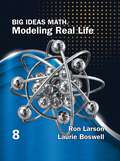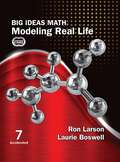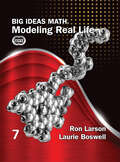- Table View
- List View
Big Ideas Math Modeling Real Life 2022 Grade 7 Advanced
by Ron Larson & Laurie BoswellBig Ideas Math Modeling Real Life 2022 Grade 7 Advanced
Big Ideas Math Modeling Real Life 2022 Grade 8
by Ron Larson & Laurie BoswellBig Ideas Math Modeling Real Life 2022 Grade 8
Big Ideas Math Modeling Real Life 2022 Grade K
by Ron Larson & Laurie BoswellBig Ideas Math Modeling Real Life 2022 Grade K
Big Ideas Math Modeling Real Life 2022 Grade K Spanish
by Ron Larson & Laurie BoswellBig Ideas Math Modeling Real Life 2022 Grade K Spanish
Big Ideas Math Modeling Real Life Common Core 2022 Grade 1
by Ron Larson & Laurie BoswellBig Ideas Math Modeling Real Life Common Core 2022 Grade 1
Big Ideas Math Modeling Real Life Common Core 2022 Grade 3
by Ron Larson & Laurie BoswellBig Ideas Math Modeling Real Life Common Core 2022 Grade 3
Big Ideas Math Modeling Real Life Common Core 2022 Grade 4
by Ron Larson & Laurie BoswellBig Ideas Math Modeling Real Life Common Core 2022 Grade 4
Big Ideas Math Modeling Real Life Common Core 2022 Grade 5
by Ron Larson & Laurie BoswellBig Ideas Math Modeling Real Life Common Core 2022 Grade 5
Big Ideas Math Modeling Real Life Common Core 2022 Grade 7 Accelerated
by Ron Larson & Laurie BoswellBig Ideas Math Modeling Real Life Common Core 2022 Grade 7 Accelerated
Big Ideas Math Modeling Real Life Common Core 2022 Grade 8
by Ron Larson & Laurie BoswellBig Ideas Math Modeling Real Life Common Core 2022 Grade 8
Big Ideas Math Modeling Real Life Common Core 2022 Grade K
by Ron Larson & Laurie BoswellBig Ideas Math Modeling Real Life Common Core 2022 Grade K
Big Ideas Math Modeling Real Life Common Core 7
by Ron Larson Laura BoswellBig Ideas Math Modeling Real Life Common Core 7
Big Ideas Math Red Accelerated, Record and Practice Journal
by Big Ideas Learning LLCNIMAC-sourced textbook
Big Ideas Math [Modeling Real Life], Skills Review Handbook
by Big Ideas Learning Llc.NIMAC-sourced textbook
Big Ideas Math a Common Core Curriculum (Red)
by Ron Larson Laurie BoswellThe Big Ideas Math series exposes students to highly motivating and relevant problems and also prepares students to meet the challenge of PARCC and Smarter Balanced testing.
Big Ideas Math, Advanced 1: A Bridge to Success
by Ron Larson Laurie BoswellNIMAC-sourced textbook <P><P>The Big Ideas Math: A Bridge to Success Student Edition features several components to help position students for success, and keep them on the right track for mathematical proficiency. The Big Ideas Math Student Edition provides students with diverse opportunities to develop problem-solving and communication skills through deductive reasoning and exploration. Students gain a deeper understanding of math concepts by narrowing their focus to fewer topics at each grade level. Students master content through inductive reasoning opportunities, engaging activites that provide deeper understanding, concise, stepped-out examples, rich, thought-provoking exercises, and a continual building on what has previously been taught.
Big Ideas Math, Course 1, A Bridge to Success: A Bridge To Success
by Ron Larson Laurie BoswellNIMAC-sourced textbook
Big Ideas Math, Grade 8: Modeling Real Life
by Ron Larson<P><P>*This textbook has been transcribed in UEB, formatted according to Braille textbook formats, proofread and corrected. <P><P>The Big Ideas Math: Modeling Real Life Student Edition features several components to help position students for success and keep them on the right track for mathematical proficiency. The Big Ideas Math Student Edition provides students with learning targets and success criteria at the chapter and lesson level to make learning visible. Diverse opportunities to develop problem-solving and communication skills through deductive reasoning and exploration are also prominent throughout the text. Students gain a deeper understanding of math concepts by narrowing their focus to fewer topics at each grade level. Students master content through inductive reasoning opportunities, engaging activities that provide deeper understanding, concise, stepped-out examples, rich, thought-provoking exercises, and building connections to previous skills for coherence.
Big Ideas Math: A Common Core Curriculum, Advanced 1
by Ron Larson Laurie BoswellNIMAC-sourced textbook











